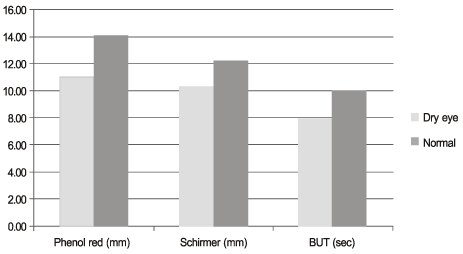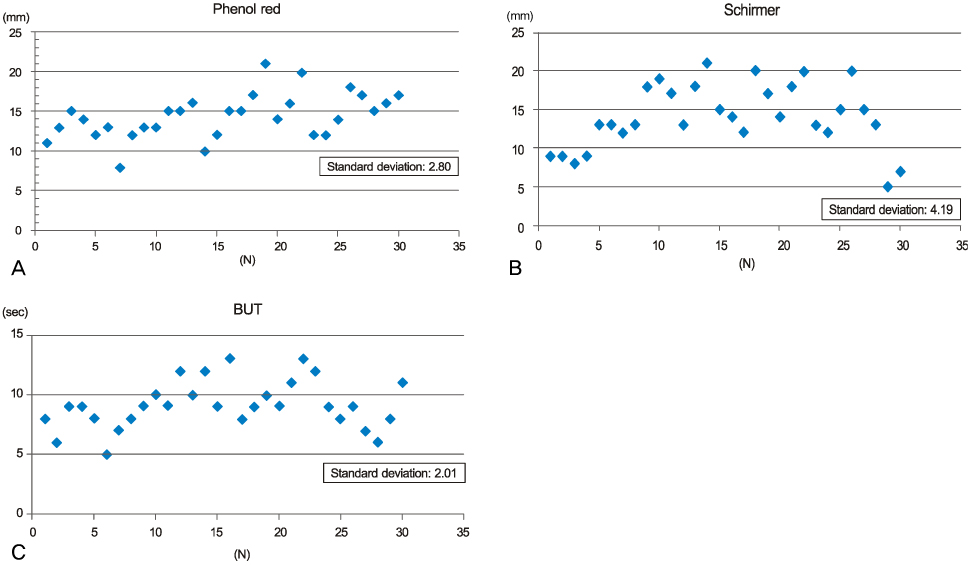J Korean Ophthalmol Soc.
2012 Feb;53(2):193-199.
Clinical Usefulness of the Phenol Red Thread Test as Diagnostic Tool in Dry Eye Patient
- Affiliations
-
- 1Department of Ophthalmology, College of Medicine, Chung-Ang University, Seoul, Korea. jck50ey@kornet.net
Abstract
- PURPOSE
To evaluate the clinical usefulness of the phenol red thread test as a diagnostic tool of dry eye by comparing the phenol red thread test, Schirmer's test and tear break-up time.
METHODS
The present study included 30 dry eye patients belonging to dry eye workshop grade 1 or 2 and 25 normal subjects. Phenol red thread test, Schirmer's test, and tear break-up time were performed on each subject's right eye. The sensitivity, specificity and repeatability of each test were compared, and the correlations between the 3 tests were also analyzed.
RESULTS
Tear break-up time was superior to the other tests in terms of sensitivity and repeatability. The phenol red thread test was better than Schirmer's test in terms of specificity and repeatability. In all 55 patients including dry eye patients and normal subjects, the phenol red thread test showed a greater correlation with tear break-up time than did Schirmer's test. In addition, in 25 dry eye patients, the correlation between the phenol red thread test and Schirmer's test increased significantly.
CONCLUSIONS
The phenol red thread test is less irritating and requires a shorter testing time than Schirmer's test. Additionally, the phenol red thread test is superior to Schirmer's test in terms of specificity, repeatability, and relation to tear break-up time. In addition, the correlation between the phenol red thread test and Schirmer's test significantly increases in dry eye patients. Therefore, the phenol red thread test is a good substitute option for Schirmer's test in diagnosing dry eye.
Keyword
MeSH Terms
Figure
Reference
-
1. The definition and classification of dry eye disease: report of the Definition and Classification Subcommittee of the International Dry Eye WorkShop (2007). Ocul Surf. 2007. 5:75–92.2. Norn MS. Desiccation of the precorneal film. I. Corneal wetting time. Acta Ophthalmol (Copenh). 1969. 47:865–880.3. Lemp MA. Report of the National Eye Institute/Industry workshop on Clinical Trials in Dry Eyes. CLAO J. 1995. 21:221–232.4. Halberg GP, Berens C. Standardized Schirmer tear test kit. Am J Ophthalmol. 1961. 51:840–842.5. Maurice D. The Charles Prentice award lecture 1989: the physiology of tears. Optom Vis Sci. 1990. 67:391–399.6. Clinch TE, Benedetto DA, Felberq NT, Laibson PR. Schirmer's test: A closer look. Arch Ophthalmol. 1983. 101:1383–1386.7. Hamano H, Hori M, Hamano T, et al. A new method for measuring tears. CLAO J. 1983. 9:281–289.8. Mackie IA, Seal DV. The questionably dry eye. Br J Ophthalmol. 1981. 65:2–9.9. Farris RL, Gilbard JP, Stuchell RN, Mandel ID. Diagnostic tests in keratoconjunctivitis sicca. CLAO J. 1983. 9:23–28.10. Lucca JA, Nunez JN, Farris RL. A comparison of diagnostic tests for keratoconjunctivitis sicca: lactoplate, Schirmer, and tear osmolarity. CLAO J. 1990. 16:109–112.11. Kurihashi K. Cotton thread method for measuring lacrimation (author's transl). Klin Monbl Augenheilkd. 1978. 172:876–879.12. Sakamoto R, Bennett ES, Henry VA, et al. The phenol red thread test: a cross-cultural study. Invest Ophthalmol Vis Sci. 1993. 34:3510–3514.13. Cho P. The cotton thread test: a brief review and a clinical study of its reliability on Hong Kong-Chinese. Optom Vis Sci. 1993. 70:804–808.14. Little SA, Bruce AS. Repeatability of the phenol red thread and tear thinning time test for tear film function. Clin Exp Optom. 1994. 77:64–68.15. Lee JH, Hyun PM. The reproducibility of Schirmer test. Korean J Ophthalmol. 1988. 2:5–8.16. Wright JC, Meger GE. A review of the Schirmer test for tear production. Arch Ophthalmol. 1962. 67:564–565.17. Chiang B, Asbell PA, Franklin B. Phenol-red thread test and Schirmer test for tear production in normal and dry eye patients. Invest Ophthalmol Vis Sci. 1988. 29:suppl. 337.18. Nichols KK, Nichols JJ, Lynn Mitchell G. The relation between tear film tests in patients with dry eye disease. Ophthalmic Physiol Opt. 2003. 23:553–560.19. Saleh TA, McDermott B, Bates AK, Ewings P. Phenol red thread test vs Schirmer's test: a comparative study. Eye. 2006. 20:913–915.20. Methodologies to diagnose and monitor dry eye disease: report of the diagnostic methodology subcommittee of the International Dry Eye WorkShop (2007). Ocul Surf. 2007. 5:108–152.21. Cho P, Chan CC. Interexaminer difference and the effect of training on the phenol red thread test results in Hong Kong-Chinese. Optom Vis Sci. 2003. 80:820–825.22. Tomlinson A, Blades KJ, Pearce EI. What does the phenol red thread test actually measure? Optom Vis Sci. 2001. 78:142–146.




